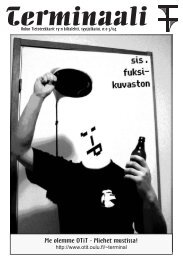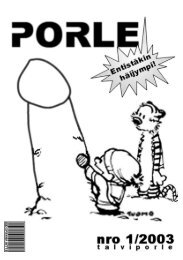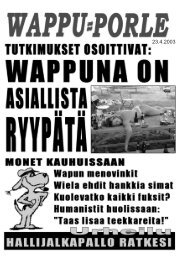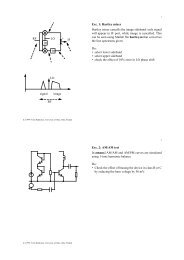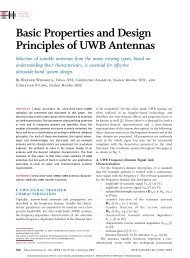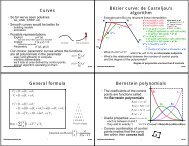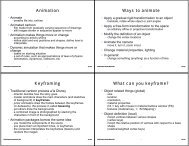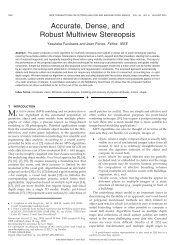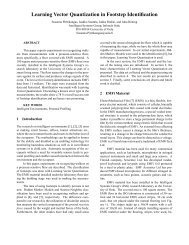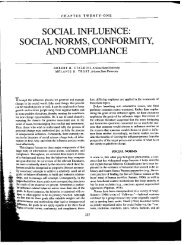On the Effect of Radio Channel Propagation Models - Oulu
On the Effect of Radio Channel Propagation Models - Oulu
On the Effect of Radio Channel Propagation Models - Oulu
You also want an ePaper? Increase the reach of your titles
YUMPU automatically turns print PDFs into web optimized ePapers that Google loves.
transmission power for desired range when <strong>the</strong> path-loss<br />
model and all <strong>the</strong> signal losses are known (in reality this<br />
would be just estimation). When <strong>the</strong> receiver bandwidth<br />
(B) is 63 MHz and <strong>the</strong> receiver effective noise temperature<br />
(T) is 290 K, <strong>the</strong> noise power can be calculated as<br />
PN = kTB 1.379 .23290K 63 106Hz<br />
2.519e-3W<br />
where k is <strong>the</strong> Boltzmann's constant. Thus, <strong>the</strong> received<br />
power requirement is<br />
PRX = YbPN 2.30 -2.519 -10 W -92 dBm (6)<br />
Taking into account <strong>the</strong> 18 dB processing gain, <strong>the</strong> PRX<br />
drops to about -110 dBm.<br />
With FPL we get path loss for 250 m to be 132.12 dB<br />
when h,t and hrx are assumed to be 2 m andfis 2.4315 GHz<br />
in <strong>the</strong> ISM band. Since antennas are omnidirectional, antenna<br />
gains are 0 dB, <strong>the</strong> transmitted power should<br />
be PTX = PX /LWfe =0. 15 W . In <strong>the</strong> case <strong>of</strong> FSL, <strong>the</strong> path loss<br />
for 250 m is 88.13 dB and <strong>the</strong> corresponding PTX should be<br />
6 [tW. As a point <strong>of</strong> comparison, we take two cut propagation<br />
models, where <strong>the</strong> signal propagates according to FSL<br />
until it is cut. In <strong>the</strong> high power CP-HP model, 100 mW<br />
transmission power is used, and in <strong>the</strong> low power CP-LP<br />
model, <strong>the</strong> same power is used as in <strong>the</strong> FSL case (6 [tW).<br />
C. Interference Modeling<br />
In <strong>the</strong> simple models, MAI is not actually calculated. The<br />
usual solution is that if two or more signals are seen at <strong>the</strong><br />
same receiver, <strong>the</strong> strongest one (possibly above some<br />
threshold) is selected to be received and <strong>the</strong> o<strong>the</strong>rs are considered<br />
lost. This kind <strong>of</strong> modeling is used at least in <strong>the</strong><br />
older versions <strong>of</strong> ns-2 [16], [3]. In <strong>the</strong> even simpler model,<br />
no power levels are calculated, but it is just decided (e.g.,<br />
based on <strong>the</strong> arrival time) which signal is received and<br />
which are lost, or in <strong>the</strong> pessimistic assumption, all signals<br />
are always considered lost in <strong>the</strong> case <strong>of</strong> a collision.<br />
OPNET has an efficient inbuilt link budget calculation system.<br />
It calculates <strong>the</strong> received signal power level according<br />
to <strong>the</strong> used propagation model (FSL as default) taking into<br />
consideration all relevant parameters (antenna gains,<br />
transmit power, processing gain, etc.). In addition to background<br />
noise, <strong>the</strong> interference caused by o<strong>the</strong>r transmissions<br />
is also added to <strong>the</strong> SINR (signal to noise and interference<br />
ratio) calculation. The calculated interference from<br />
o<strong>the</strong>r transmissions is added directly to <strong>the</strong> total noise<br />
power. In spread spectrum modeling, <strong>the</strong> signal spread<br />
with <strong>the</strong> correct code is recovered with processing gain,<br />
which is equal to <strong>the</strong> spreading factor (spreading code rate<br />
/ data rate). Hence, <strong>the</strong> calculation is done on <strong>the</strong> power<br />
level basis and no actual correlations with <strong>the</strong> interfering<br />
(5)<br />
4 <strong>of</strong> 7<br />
signals are calculated. This, <strong>of</strong> course, can bring some<br />
inaccuracy, but assuming a spreading code family with<br />
well known cross correlation properties (like gold sequences<br />
[17]), this simplification is fair enough. The accurate<br />
signal-level calculation is a heavy process and it<br />
would be (currently) almost impossible in bigger network<br />
simulations. Instead, OPNET provides a possibility<br />
to use own SNR-BER behavior curves, which can be<br />
used to model accurate physical level behavior.<br />
As a consequence, OPNET models MAI accurately<br />
enough for our purposes. It can be anticipated that cut<br />
propagation modeling will give too optimistic view <strong>of</strong><br />
<strong>the</strong> performance since it does not consider MAI outside<br />
<strong>the</strong> defined radio range. Some interesting approaches for<br />
MAI modeling in network level simulations have been<br />
also presented, where nodes have longer interference<br />
range in addition to radio range for successful data<br />
transmission [18]. Although this is a step towards more<br />
accurate modeling, it does not yet give proper idea about<br />
<strong>the</strong> effect <strong>of</strong> MAI, since in reality, <strong>the</strong> signals propagate<br />
to infinity (in <strong>the</strong> absence <strong>of</strong> physical barriers). The reason<br />
behind <strong>the</strong> wide usage <strong>of</strong> cut propagation modeling<br />
is its simplicity. Accurate MAI modeling is computationally<br />
costly, since <strong>the</strong> link budget calculations must be<br />
made to every node in a scenario per single transmission.<br />
0<br />
-20<br />
<strong>Propagation</strong> distance [m]<br />
10 20 300 40 500 600 700 800 900 1000<br />
- 40m<br />
-FPL<br />
2 60<br />
> ~~~~~~~~~~~FSL<br />
ti 80ndetection level<br />
-D _100-<br />
-.,120-<br />
140<br />
160<br />
-180<br />
-200 _LL LL<br />
Figure 1. Received power level as a function <strong>of</strong> propagation<br />
distance<br />
In FPL model <strong>the</strong> signal attenuates heavily, which sets<br />
challenges to <strong>the</strong> communications as compared to free<br />
space propagation. However, in terms <strong>of</strong> MAI, <strong>the</strong> situation<br />
is quite interesting. Because <strong>of</strong> <strong>the</strong> heavy propagation<br />
loss, <strong>the</strong> long range MAI is, in fact, clearly weaker<br />
than it is with free space loss. This can be easily seen<br />
from Figure 1, where <strong>the</strong> received power level is represented<br />
as a function <strong>of</strong> propagation distance. In <strong>the</strong> FPL<br />
model, <strong>the</strong> curve's starting point is naturally higher,<br />
since <strong>the</strong> transmission power needs to be higher than in<br />
<strong>the</strong> FSL model. Signal detection level (about -110 dBm)<br />
is also shown in <strong>the</strong> figure, which <strong>of</strong> course, intersects<br />
with <strong>the</strong> o<strong>the</strong>r curves at <strong>the</strong> effective radio range <strong>of</strong>




